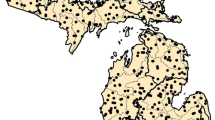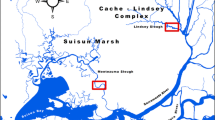Abstract
Conditions fostering coexistence of native species with invasive species have received little attention in invasion biology, especially for closely related invasive and native species. We used long-term datasets on multiple replicate invasions to define conditions under which native virile crayfish (Orconectes virilis) can coexist with invasive rusty crayfish (O. rusticus). We examined multiple drivers of coexistence involving habitat use and predation at between-lake and within-lake scales to derive predictions that could guide prioritization efforts to prevent future introductions of rusty crayfish and mitigate impacts of existing invasions. Lakes in which native species persisted for many years had significantly less cobble and sand habitats, and significantly more vegetated habitats compared to lakes from which native crayfish have been displaced. In the presence of rusty crayfish, virile crayfish alter their habitat use to vegetated habitats relative to habitat use in the absence of rusty crayfish. Such vegetated habitats had greater plant standing crop, plant species richness, and sediment percent organic matter compared to vegetated sites occupied by rusty crayfish. Our results suggest that low abundance of cobble habitat and altered habitat use allows native crayfish to coexist with the rusty crayfish invader. At the within-lake scale, virile crayfish persist by escaping predation in the vegetated habitats, despite suboptimal abiotic conditions. By understanding these abiotic and biotic conditions that promote coexistence, managers could enhance native crayfish persistence by targeting high cobble lakes for efforts to prevent the introduction of invasive crayfish, and targeting vegetated habitats for protection in already invaded lakes.







Similar content being viewed by others
References
Bailey RJE, Dick JTA, Elwood RW, MacNeil C (2006) Predatory interactions between the invasive amphipod Gammarus tigrinus and the native opossum shrimp Mysis relicta. J N Am Benth Soc 25(2):393–405
Bobeldyk AM, Lamberti GA (2010) Stream food web responses to a large omnivorous invader, Orconectes rusticus (Decapoda, Cambaridae). Crustaceana 83(6):641–657
Bonesi L, Macdonald DW (2004) Differential habitat use promotes sustainable coexistence between the specialist otter and the generalist mink. Oikos 106:509–519
Borman S, Korth R, Temte J (1997) Through the looking glass: a field guide to aquatic plants. Wisconsin Lakes Partnership, Stevens Point
Bossenbroek JM, McNulty J, Keller RP (2005) Can ecologist heat up the discussion on invasive species risk? Risk Anal 25(6):2005
Bossenbroek JM, Johnson LE, Peters B, Lodge DM (2007) Forecasting the expansion of zebra mussels in the United States. Conserv Biol 21(3):800–810
Bryce J, Johnson PJ, Macdonald DW (2002) Can niche use in red and grey squirrels offer clues for their apparent coexistence? J Appl Ecol 39:875–887
Capelli GM (1982) Displacement of northern Wisconsin crayfish by Orconectes rusticus (Girard). Limnol Oceanogr 27(4):741–745
Capelli GM, Magnuson JJ (1983) Morphoedaphic and biogeographic analysis of crayfish distribution in northern Wisconsin. J Crustac Biol 3:548–564
Carpenter SR, Lodge DM (1986) Effects of submersed macrophytes on ecosystem processes. Aquat Bot 26:341–370
Celik K, Schindler JE, Foris WJ, Knight JC (2002) Predator-mediated coexistence of exotic and native crustaceans in a freshwater lake? Biol Invasions 4:451–454
Chase JM, Leibold MA (2003) Ecological niches: linking classical and contemporary approaches. University of Chicago Press, Chicago
Crooks JA (2005) Lag times and exotic species: the ecology and management of biological invasions in slow-motion. Ecoscience 12(3):316–329
Crow GE, Hellquist CB, Fassett NC (2000) Aquatic and wetland plants of Northeastern North America: a revised and enlarged edition of Norman C. Fassett’s a manual of aquatic plants. University of Wisconsin Press, Madison
Didonato GT, Lodge DM (1993) Species replacements among Orconectes crayfishes in Wisconsin lake: the role of predation by fish. Can J Fish Aquat Sci 50:1484–1488
Fox JW, Barreto C (2006) Surprising competitive coexistence in a classic model system. Community Ecol 7(2):143–154
Garvey JE, Rettig JE, Stein RA, Lodge DM, Klosiewski SP (2003) Scale-dependent associations among fish predation, littoral habitat, and distributions of crayfish species. Ecology 84(12):3339–3348
Gurevitch J, Padilla DK (2004) Are invasive species a major cause of extinctions? Trends Ecol Evol 19(9):470–474
Harrington LA, Harrington AL, Yamaguchi N, Thom MD, Ferreras P, Windham TR, Macdonald DW (2009) The impact of native competitors on an alien invasive: temporal niche shifts to avoid interspecific aggression? Ecology 90(5):1207–1216
Hein CL, Vander Zanden MJ, Magnuson JJ (2007) Intensive trapping and increased fish predation cause massive population decline of an invasive crayfish. Freshw Biol 52:1134–1146
Hesselschwerdt J, Necker J, Wantzen KM (2008) Gammarids in Lake Constance: habitat segregation between the invasive Dikerogrammarus villosus and the indigenous Gammarus roeselii. Arch Hydrobiol 173(3):177–186
Hill AM, Lodge DM (1994) Diel changes in resource demand: competition and predation in species replacement among crayfishes. Ecology 75(7):2118–2126
Hill AM, Lodge DM (1999) Replacement of resident crayfishes by an exotic crayfish: the roles of competition and predation. Ecol Appl 9:678–690
Hobbs HH, Lodge DM (2009) Decapoda. In: Thorp JH, Covich AP (eds) Ecology and classification of North American freshwater invertebrates, 3rd edn. Academic Press, New York, pp 901–967
Holt RD (1977) Predation, apparent competition, and the structure of prey communities. Theor Popul Biol 12:197–229
Huffaker CB (1958) Experimental studies on predation: dispersion factors and predator-prey oscillations. Hilgardia 27(14):343–383
Hutchinson GE (1961) The paradox of the plankton. Am Nat 95:137–145
Keller RP, Drake JM, Lodge DM (2006) Fecundity as a basis for risk assessment of nonindigenous freshwater mollusks. Conserv Biol 21(1):191–200
Kellogg CM, Dorn NJ (2012) Consumptive effects of fish reduce wetland crayfish recruitment and drive species turnover. Oecologia 168:1111–1121
Kershner MW, Lodge DM (1995) Effects of littoral habitat and fish predation on the distribution of an exotic crayfish, Orconectes rusticus. J N Am Benth Soc 14(3):414–422
Kesavaraju B, Damal K, Juliano SA (2008) Do natural container habitats impede invader dominance? Predator-mediated coexistence of invasive and native container-dwelling mosquitoes. Oecologia 155:631–639
Kolar CS, Lodge DM (2001) Progress in invasion biology: predicting invaders. Trends Ecol Evol 16(4):199–204
Laha M, Mattingly HT (2006) Identifying environmental conditions to promote species coexistence: an example with the native Barrens topminnow and invasive western mosquitofish. Biol Invasions 8:719–725
Lewin R (1983) Santa Rosalia was a goat. Science 221:636–639
Lippson RL (1976) The distribution of the crayfishes of Michigan with aspects of their life cycle and physiology. PhD dissertation. Michigan State University
Lodge DM (1993) Biological invasions: lessons for ecology. Trends Ecol Evol 8(4):133–137
Lodge DM, Hill AM (1994) Factors governing species composition, population size, and productivity of cool-water crayfishes. Nord J Freshw Res 69:111–136
Lodge DM, Kratz TK, Capelli GM (1986) Long-term dynamics of three crayfish species in Trout Lake, Wisconsin. Can J Fish Aquat Sci 43:993–999
Lodge DM, Kershner ME, Aloi JE, Covich AP (1994) Effects of an omnivorous crayfish (Orconectes rusticus) on a fresh-water littoral food-web. Ecology 75:1265–1281
Lodge DM, Stein RA, Brown KM, Covich AP, Bronmark C, Garvey JE, Klosiewski SP (1998) Predicting impact of freshwater exotic species on native biodiversity: challenges in spatial scaling. Aust J Ecol 23:53–67
Lodge DM, Williams S, MacIsaac HJ, Hayes KR, Leung B, Reichard S, Mack RN, Moyle PB, Smith M, Andow DA, Carlton JT, McMichael A (2006) Biological invasions: recommendations for US policy and management. Ecol Appl 16(6):2035–2054
MacDougall AS, Gilbert B, Levine JM (2009) Plant invasions and the niche. J Ecol 97:609–615
MacIsaac HJ, Borbely JVM, Muirhead JR, Graniero PA (2004) Backcasting and forecasting biological invasions of inland lakes. Ecol Appl 14(3):773–783
Mack RN (2005) Assessing biotic invasions in time and space: the second imperative. In: Mooney HA, Mack RN, McNeely JA, Neville LE, Schei PJ, Waage JK (eds) Invasive alien species: a new synthesis. Island Press, Washington, DC, pp 179–208
MacNeil C, Dick JTA, Elwood RW, Montgomery WI (2001a) Coexistence among native and introduced freshwater amphipods (Crustacea); habitat utilization patterns in littoral habitats. Arch Hydrobiol 151(4):591–607
MacNeil C, Montgomery WI, Dick JTA, Elwood RW (2001b) Factors influencing the distribution of native and introduced Gammarus spp. Irish river systems. Arch Hydriobiol 151(3):353–368
MacNeil C, Fielding NJ, Dick JTA, Briffa M, Prenter J, Hatcher MJ, Dunn AM (2003) An acanthocephalan parasite mediates intraguild predation between invasive and native freshwater amphipods (Crustacea). Freshw Biol 48:2085–2093
Olsen TM, Lodge DM, Capelli GM, Houlihan RJ (1991) Mechanisms of impact of an introduced crayfish (Orconectes rusticus) on littoral congeners, snails, and macrophytes. Can J Fish Aquat Sci 48:1853–1861
Paine RT (1966) Food web complexity and species diversity. Am Nat 100:65–75
Palmer ME, Ricciardi A (2004) Physical factors affecting the relative abundance of native and invasive amphipods in the St. Lawrence River. Can J Zool 82:1886–1893
Palmer ME, Ricciardi A (2005) Community interactions affecting the relative abundances of native and invasive amphipods in the St. Lawrence River. Can J Fish Aquat Sci 62:1111–1118
Perry WL, Feder JL, Dwyer G, Lodge DM (2001) Hybrid zone dynamics and species replacement between Orconectes crayfishes in a northern Wisconsin lake. Evolution 55(6):1153–1166
Peters BW (2010) Evaluating strategies for controlling invasive crayfish using human and fish predation. Master’s thesis. University of Notre Dame
Peters JA, Lodge DM (2009) Invasive species policy at the regional level: a multiple weak links problem. Fisheries 34(8):373–381
Peters JA, Kreps T, Lodge DM (2008) Assessing the impacts of rusty crayfish (Orconectes rusticus) on submergent macrophytes in a north-temperate US lake using electric fences. Am Midl Nat 159:287–297
Pfister CA (2006) Concordance between short-term experiments and long-term censuses in tide pool fishes. Ecology 87(11):2905–2914
Priddis E, Rader R, Belk M, Schaalje B, Merkley S (2009) Can separation along the temperature niche axis promote coexistence between native and invasive species? Divers Distrib 15:682–691
Puth LM, Post DM (2005) Studying invasion: have we missed the boat? Ecol Lett 8:715–721
Rosenthal SK, Stevens SS, Lodge DM (2006) Whole-lake effects of invasive crayfish (Orconectes spp.) and the potential for restoration. Can J Fish Aquat Sci 63:1276–1285
Roth BM, Tetzlaff JC, Alexander ML, Kitchel JF (2007) Reciprocal relationships between exotic rusty crayfish, macrophytes, and Lepomis species in Northern Wisconsin lakes. Ecosystems 10:74–85
Sax DF, Gaines SD (2003) Species diversity: from global decreases to local increases. Trends Ecol Evol 18(11):561–566
Sax DF, Stachowicz JJ, Gaines SD (2005) Species invasions: insights into ecology, evolution, and biogeography. Sinauer Associates, Sunderland
Shea K, Chesson P (2002) Community ecology theory as a framework for biological invasions. Trends Ecol Evol 17(4):170–176
Steinman AD, Lamberti GA, Leavitt PR (2006) Biomass and pigments of benthic algae. In: Hauer FR, Lamberti GA (eds) Methods in stream ecology. Elsevier, New York, pp 357–379
Taylor CA, Redmer M (1996) Dispersal of the crayfish Orconectes rusticus in Illinois, with notes on species displacement and habitat preference. J Crustac Biol 16:547–551
Vaughn CC, Spooner DE (2006) Scale-dependent associations between native freshwater mussels and invasive Corbicula. Hydrobiologia 568:331–339
Werner EE, Hall DJ (1976) Niche shifts in sunfishes: experimental evidence and significance. Science 191(4225):404–406
Wetzel RG (2001) Limnology: lake and river ecosystems. Academic Press, New York
Wilcove DS, Rothstein D, Dubow J, Phillips A, Losos E (1998) Quantifying threats to imperiled species in the United States. Bioscience 48(8):607–615
Zanatta DT, Mackie GL, Metcalfe-Smith JL, Woolnough DA (2002) A refuge for native freshwater mussels (Bivalvia: Unionidae) from impacts of the exotic zebra mussel (Dreissena polymorpha) in Lake St. Clair. J Gt Lakes Res 28(3):479–489
Acknowledgments
All Lodge lab members provided valuable input during the development of this manuscript with Brett Peters, Matt Barnes, and Chris Jerde providing specific comments regarding the manuscript and the statistical analyses. Reviews provided by Francesca Gherardi and Nate Dorn led to valuable improvements in the manuscript. Rebecca Hale, Tyler Cullender, Angela Deen, Sarah Baker, and Sarah Sutton assisted with field work and sample processing. Funding for this project came from a National Science Foundation Graduate Research Fellowship; from the National Science Foundation Integrated Systems for Invasive Species (ISIS) project (DML, P.I.: DEB 02-13698); and from the University of Notre Dame Environmental Research Center.
Author information
Authors and Affiliations
Corresponding author
Electronic supplementary material
Below is the link to the electronic supplementary material.
Rights and permissions
About this article
Cite this article
Peters, J.A., Lodge, D.M. Habitat, predation, and coexistence between invasive and native crayfishes: prioritizing lakes for invasion prevention. Biol Invasions 15, 2489–2502 (2013). https://doi.org/10.1007/s10530-013-0468-1
Received:
Accepted:
Published:
Issue Date:
DOI: https://doi.org/10.1007/s10530-013-0468-1




